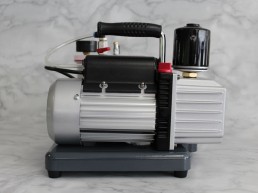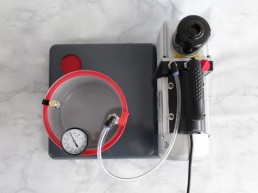Vacuum Degassing
Easy to Use, Efficient, Effective, Plug & Play Vacuum Degassing Chambers
Speedivac Vacuum Degassing Chamber VDC 3
- 15cm diameter x 15cm height
- 3 Litre chamber
- Fitted with a Speedivac Vacuum Pump
- Clear Acrylic lid to monitor the vacuum degassing process
- Vacuum Gauge
- **Oil mist filter to minimise exhaust fumes
Contact us for pricing.
*Images are for display purposes only and the actual product may vary slightly.
**Oil Mist Filter is an optional extra.
*Price includes delivery to main centres in South Africa via road transport.
Speedivac Vacuum Degassing Chamber VDC 12
- 25cm diameter x 25cm height
- 12 Litre chamber
- Fitted with a Speedivac Vacuum Pump
- Clear Acrylic lid to monitor the vacuum degassing process
- Vacuum Gauge
- **Oil mist filter to minimise exhaust fumes
Contact us for pricing.
*Images are for display purposes only and the actual product may vary slightly.
**Oil Mist Filter is an optional extra.
*Price includes delivery to main centres in South Africa via road transport.
WHAT IS VACUUM DEGASSING?
The vacuum degassing process
All liquids contain air, which may be visible as bubbles in the liquid or in a less visible dissolved form. When making moulds and castings, air is trapped in the liquid during the mixing of component parts and during pouring. If this air is not removed from silicone or resin prior to making moulds and castings the bubbles will produce defects in the moulds, which in turn will be replicated in the resin castings made using these defective moulds. Usually, the defect will be visible as bubbles on the surface of the mould or as bubbles in the casting. Bubbles in castings ruin the appearance of the finished product, particularly in clear resins, and also result in weakened mechanical parts. Our Speedivac Vacuum Degassing Chamber Systems are ideal for removing trapped air and for producing a higher-quality final product.
Speedivac Vacuum Degassing Chambers
To remove bubbles, the resin or silicone is placed in the vacuum chamber and subjected to reduced pressure (Vacuum). The reduced pressure causes the bubbles to expand and rise to the surface of the liquid and burst. The air released is then pumped away by the Vacuum Pump. The degassing process requires a certain minimum level of vacuum. Typically bubbles will start to rise to the liquid surface at about 95% vacuum (50 Millibars absolute) Air release becomes more vigorous as the vacuum improves and peaks at about 98% vacuum (20 Millibars). If this level of vacuum is not achieved, then the liquid, particularly thick viscous liquids, will only be partially degassed.
When degassing liquid, it will start to bubble, then foam and rise in the container as degassing accelerates. For example, degassing silicone will result in an expansion of up to three times its original volume. Once the air is released then, the liquid will collapse and settle; at this point, vacuum may be maintained for an additional thirty to sixty seconds while you wait for bubbles on the surface of the liquid to burst.
Always be aware of the pot life (cure time) of the product when degassing. If the pot life is very short, such as with Smooth-on’s F16 urethane, parts A and B may be degassed individually in the vacuum degassing unit and then degassed again for a shorter period after mixing. Be aware that resin cure times are shorter in hot weather. For videos on how to make moulds and castings, visit Smooth-on® USA. These videos will guide you through the basics, providing information on methods and materials.
Features of Speedivac Vacuum Degassing Chambers
- Completely assembled Plug & Play system ready for use
- Efficient vacuum (99.9%)
- Superior degassing produces better-quality moulds and castings
- Fast pump down
- Ideal for resins with a short pot life
- Clear acrylic chamber lid allows the degassing process to be monitored for better results
- Chamber lid seals automatically; no clamps required
- Fast cycle times
- Silicone chamber seal for long life and low maintenance
- Vacuum Gauge allows chamber pressure to be monitored for consistent results
- Vent valve to break vacuum: may be used to regulate the chamber vacuum
- May be used as a vacuum pumping station for other applications
- Lightweight and easy to transport: All components are mounted on a common base, with nothing to disconnect when moving the system
Typical applications for Speedivac Vacuum Degassing Chambers
- Degassing silicone
- Impregnation of materials
- Degassing of moulds after filling
- Stabilization of wood for making knife handles and pens
- Degassing resin
- Storage of sensitive products under vacuum
- Degassing of inks before filling cartridges
- Encapsulation of components and electrical circuits
- Degassing of investments for jewellery manufacture
- May be used as a Vacuum Pump station for other vacuum applications








